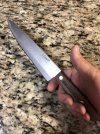Trubetzkoy
Basic Member
- Joined
- Jun 3, 2022
- Messages
- 424
Thanks for the kind words, mate. I don't know exactly what type of steel it is, but based on its age, the lack of "stainless" or "Rostfrei" marks, and the pitting on the ricasso, it's definitely high-carbon.Congrats on your latest addition
More pics please
It is a very interesting piece !
What type of steel is it ?
I admire your growing collection and appreciate your knowledge and insight.
Here are a few more pics:



The sheath has definitely seen better days. The chape is missing (as is often the case with chapes) and the throat is missing its hook and a piece on the left side. Interestingly, it seems to be lead rather than nickel silver. Originally I just wanted to make a new chape, but I might actually redo both in nickel silver.
Last edited:








